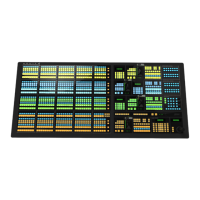Tip: Storing items individually allows you to change the order
that memories or custom controls etc. appear on the menu. This
can be useful for grouping similar or frequently used memories
together.
1. Press HOME > Disk > Dest/Source.
2. Use the Disk Type knob to select whether you want
to use the hard drive of the switcher (Hard Drive),
or a USB drive (USB).
Note: You cannot store or recall files from the USB on the
Acuity Rack Panel server. You must store or recall the files
from the Local Disk and access it over the network. Point
your file explorer to the localdisk folder on the server
(\\##.##.##.##\localdisk). The user name
is nobody and there is no password.
3. Press Store Individual and select the individual
item you want to store.
• Memory Register — individual memory
• CustCtrl Register — individual custom
control
• Sequence — individual DVE sequence
• Bus Map — individual bus map
• Shot Box Page — individual Shot Box page
• MultiViewer Layout — individual
MultiViewer layout
4. Use the From Switcher knob to select the item
you want to store.
5. Use the To Disk knob to select the location in the
setup to store the item.
6. Press Store Item.
To Name a Setup
Only setups on the hard drive can be named.
1. Press HOME > Disk > Dest/Source.
2. Use the Disk Type knob to select Hard Drive.
3. Use the Set Names knob to select the setup you
want to name.
4. Press Store > More > More > Name Setup.
5. Enter the new name for the setup and press Accept
New Name.
Recalling Setups
The switcher can recall individual registers or setups
from either the internal hard drive, located in the frame,
or a USB drive that is inserted into the USB port on the
panel. The USB drive must be formatted as FAT or
NTFS.
To Recall a Switcher Setup
Note: If the installation register you are recalling has an input
processor board (MultiProcessor Input or 12G MultiProcessor
Input) set to a different mode (Mode 1 or Mode 0) than it is
currently operating in, it will take an extended amount of time for
the input processor board to be fully functional. For example,
the Input MultiViewer will take longer to display.
Note: If you are updating an older setup file, you must perform
a Recall All followed by a Store All. This updates the setup files
to the latest format. You can then make changes and store to
individual registers if needed.
1. Press HOME > Disk > Dest/Source.
2. Use the Disk Type knob to select whether you want
to use the hard drive of the switcher (Hard Drive),
or a USB drive (USB).
Note: You cannot store or recall files from the USB on the
Acuity Rack Panel server. You must store or recall the files
from the Local Disk and access it over the network. Point
your file explorer to the localdisk folder on the server
(\\##.##.##.##\localdisk). The user name
is nobody and there is no password.
3. Use the Set Names knob to select the setup on the
drive you want to use.
4. Press Recall.
5. Select the individual registers, or all of them (All),
to be recalled from the setup. As you press the
buttons, the switcher recalls those registers from the
setup.
To Recall an Individual Register
Note: If the installation register you are recalling has an input
processor board (MultiProcessor Input or 12G MultiProcessor
Input) set to a different mode (Mode 1 or Mode 0) than it is
currently operating in, it will take an extended amount of time for
the input processor board to be fully functional. For example,
the Input MultiViewer will take longer to display.
Note: If you are updating an older setup file, you must perform
a Recall All followed by a Store All. This updates the setup files
to the latest format. You can then make changes and store to
individual registers if needed.
1. Press HOME > Disk > Dest/Source.
2. Use the Disk Type knob to select whether you want
to use the hard drive of the switcher (Hard Drive),
or a USB drive (USB).
Note: You cannot store or recall files from the USB on the
Acuity Rack Panel server. You must store or recall the files
from the Local Disk and access it over the network. Point
your file explorer to the localdisk folder on the server
(\\##.##.##.##\localdisk). The user name
is nobody and there is no password.
Acuity Operation Manual (v9.2) — Switcher Setups • 71

